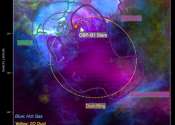Fatty acids might exist in space
A team of physicists have discovered that the environment of a molecular cloud in interstellar space can support the existence of fatty acids, a key component of life on Earth.

A team of physicists have discovered that the environment of a molecular cloud in interstellar space can support the existence of fatty acids, a key component of life on Earth.
Astronomy
May 19, 2023
0
78

Using the Five-hundred-meter Aperture Spherical radio Telescope (FAST), Chinese astronomers have observed a pair of galaxies known as Arp 269. They detected extended tidal tails emerging from this system. The finding was ...

In 2017, a mysterious comet dubbed 'Oumuamua fired the imaginations of scientists and the public alike. It was the first known visitor from outside our solar system, it had no bright coma or dust tail, like most comets, and ...
Astronomy
Mar 22, 2023
0
456

A snapshot of the Tarantula Nebula (also known as 30 Doradus) is featured in this image from the NASA/ESA Hubble Space Telescope. The Tarantula Nebula is a large star-forming region of ionized hydrogen gas that lies 161,000 ...
Astronomy
Feb 6, 2023
0
9

Understanding how dust grains form in interstellar gas could offer significant insights to astronomers and help materials scientists develop useful nanoparticles.
Planetary Sciences
Jan 13, 2023
0
68

A new simulation conducted on the world's most powerful supercomputer dedicated to astronomy has produced a testable scenario to explain the appearance of the bar of the Milky Way. Comparing this scenario to data from current ...
Astronomy
Sep 9, 2022
0
115

Astronomers studying the structure of the Milky Way galaxy have released the highest-resolution 3D view of the Orion star-forming region. The image and interactive figure were presented today at a press conference hosted ...
Astronomy
Jun 16, 2022
0
283

Using the Atacama Large Millimeter/submillimeter Array (ALMA), an international team of astronomers observed an interstellar medium in a distant star-forming galaxy SPT0346-52. The collected data could be essential in improving ...

A team of space scientists has published a paper in Annual Review of Astronomy and Astrophysics suggesting that there may be an Earth- or Mars-sized planet orbiting beyond Neptune. They further suggest that simulations of ...

Astronomers refer to all the elements heavier than helium as "metals," even elements that are typically found in gaseous form. In the big bang only hydrogen and helium (and a trace of lithium) were created while the "metals" ...
Astronomy
Aug 2, 2021
4
666